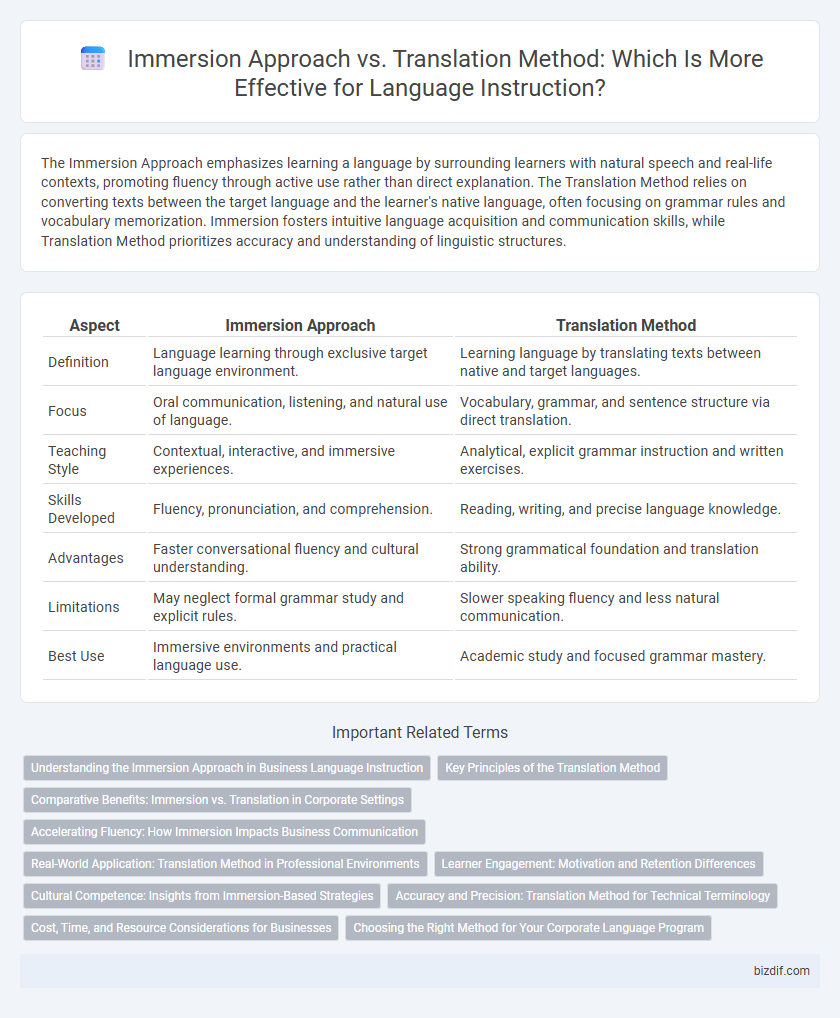The Immersion Approach emphasizes learning a language by surrounding learners with natural speech and real-life contexts, promoting fluency through active use rather than direct explanation. The Translation Method relies on converting texts between the target language and the learner's native language, often focusing on grammar rules and vocabulary memorization. Immersion fosters intuitive language acquisition and communication skills, while Translation Method prioritizes accuracy and understanding of linguistic structures.
Table of Comparison
| Aspect | Immersion Approach | Translation Method |
|---|---|---|
| Definition | Language learning through exclusive target language environment. | Learning language by translating texts between native and target languages. |
| Focus | Oral communication, listening, and natural use of language. | Vocabulary, grammar, and sentence structure via direct translation. |
| Teaching Style | Contextual, interactive, and immersive experiences. | Analytical, explicit grammar instruction and written exercises. |
| Skills Developed | Fluency, pronunciation, and comprehension. | Reading, writing, and precise language knowledge. |
| Advantages | Faster conversational fluency and cultural understanding. | Strong grammatical foundation and translation ability. |
| Limitations | May neglect formal grammar study and explicit rules. | Slower speaking fluency and less natural communication. |
| Best Use | Immersive environments and practical language use. | Academic study and focused grammar mastery. |
Understanding the Immersion Approach in Business Language Instruction
The immersion approach in business language instruction emphasizes using the target language exclusively within real-world business contexts to foster natural communication skills and cultural fluency. This method accelerates language acquisition by engaging learners in practical scenarios such as meetings, presentations, and negotiations, enhancing their ability to think and respond directly in the foreign language. Immersion promotes deeper comprehension and retention, making it especially effective for professionals aiming to operate confidently in multinational environments.
Key Principles of the Translation Method
The Translation Method centers on teaching language through direct translation between the target language and the native language, emphasizing grammar rules, vocabulary memorization, and written exercises. Key principles include a strong focus on reading and writing skills, use of bilingual texts, and minimal oral practice, making it highly structured and teacher-centered. This method contrasts with communicative approaches by prioritizing accuracy and linguistic form over spontaneous language use.
Comparative Benefits: Immersion vs. Translation in Corporate Settings
Immersion approach enhances language acquisition through contextual and interactive experiences, fostering greater fluency and practical communication skills essential for dynamic corporate environments. Translation method supports precise understanding of complex, domain-specific terminology, beneficial for accurate communication and documentation in specialized industries. Combining both methods strategically can optimize language training outcomes by balancing practical usage with technical accuracy in corporate settings.
Accelerating Fluency: How Immersion Impacts Business Communication
Immersion approach significantly accelerates fluency by surrounding learners with authentic language use, enhancing their ability to quickly grasp business-specific vocabulary and idioms. Unlike the translation method, which relies on direct linguistic comparisons and often delays natural communication skills, immersion fosters intuitive understanding and immediate application in professional settings. This method improves real-time decision-making and negotiation capabilities essential for effective business communication.
Real-World Application: Translation Method in Professional Environments
The Translation Method excels in professional environments where precise understanding of complex terminology and exact language equivalence is crucial, such as legal or medical settings. This approach enhances accuracy by allowing learners to directly compare source and target languages, fostering critical analytical skills necessary for tasks like document translation or contract review. Its structured focus on grammar and vocabulary supports high-stakes communication, ensuring clarity and reducing the risk of misinterpretation in real-world applications.
Learner Engagement: Motivation and Retention Differences
The immersion approach enhances learner engagement by surrounding students with the target language, fostering natural communication and cultural context, which significantly boosts motivation and long-term retention. In contrast, the translation method often limits interaction to isolated language components, potentially reducing intrinsic motivation and making it harder to retain language skills in real-life settings. Research indicates immersion learners show higher levels of active participation and better cognitive retention compared to those relying on translation-based instruction.
Cultural Competence: Insights from Immersion-Based Strategies
Immersion-based language instruction significantly enhances cultural competence by surrounding learners with authentic linguistic contexts and cultural nuances, fostering deeper understanding and empathy. This approach contrasts with the Translation Method, which often limits cultural exposure by focusing primarily on direct language equivalences rather than cultural immersion. Studies indicate that learners in immersion programs develop superior intercultural communication skills, essential for effective real-world interactions.
Accuracy and Precision: Translation Method for Technical Terminology
The Translation Method excels in accuracy and precision when teaching technical terminology by directly associating foreign terms with their exact equivalents in the native language, minimizing ambiguity. This approach ensures learners understand complex concepts through precise translations, which is crucial for specialized fields like medicine or engineering. Immersion, while beneficial for general language fluency, often lacks the explicit focus needed for mastering exact technical vocabulary.
Cost, Time, and Resource Considerations for Businesses
The immersion approach demands higher upfront costs due to immersive materials and native-speaking instructors, but it accelerates language acquisition, reducing long-term training time. The translation method often requires fewer specialized resources and lower initial investment, yet it extends overall learning duration and may limit practical language proficiency. Businesses must balance budget constraints with desired language competency outcomes when selecting between immersive environments and translation-based instruction.
Choosing the Right Method for Your Corporate Language Program
Selecting the most effective language instruction method for corporate programs hinges on aligning goals with employee needs and workplace context. The Immersion Approach enhances fluency and cultural competence by creating real-life, language-rich environments, ideal for roles requiring spontaneous communication and cultural nuance. The Translation Method suits technical or compliance training where precise understanding of terminology and accuracy are paramount, benefiting industries like legal, medical, or financial sectors.
Immersion Approach vs Translation Method Infographic

 bizdif.com
bizdif.com